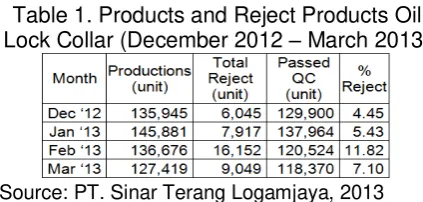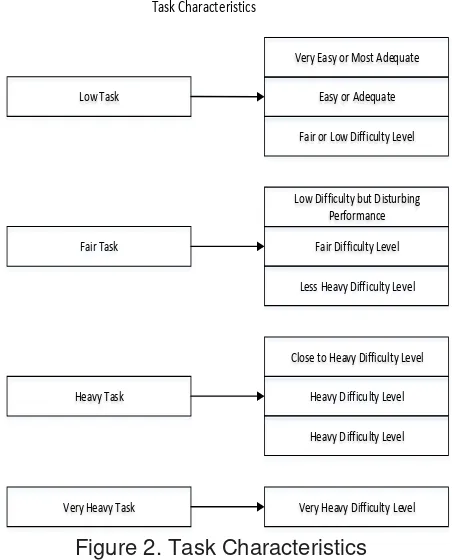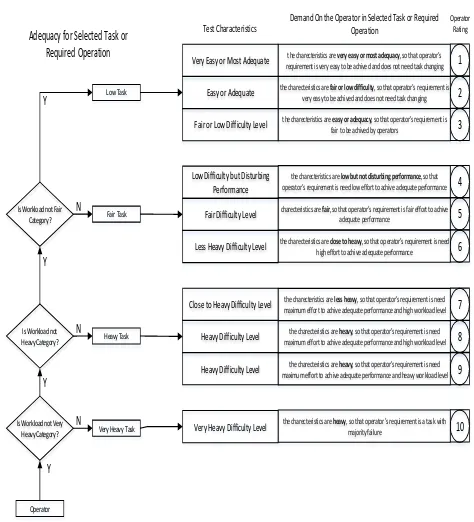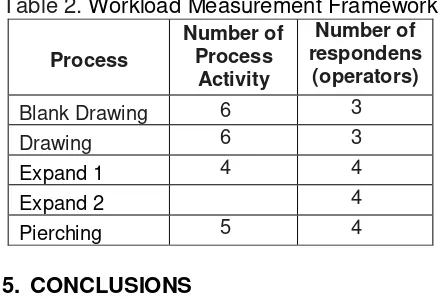FRAMEWORK DEVELOPMENT AND MEASUREMENT OF OPERATOR
WORKLOAD USING MODIFIED COOPER HARPER SCALE METHOD
(CASE STUDY IN PT SINAR TERANG LOGAMJAYA BANDUNG WEST JAVA)
Rizki Wahyuniardi1, M. Yani Syafei2, Wahyukaton3
Industrial Engineering Department, Pasundan University, Bandung, Indonesia 1
[email protected], [email protected] [email protected]
ABSTRACT
PT Sinar Terang Logamjaya is an automotive components manufacturer for motorcycles and car). The industry is dealing with materials from iron plate and process with sheet metal shaping techniques to produce products. One of the product is a motorcycle component, is called Oil Lock Collar. This product is been made in large quantities to meet demands. Hence, it is resulted in the workload experienced by workers and will touch on the productivity of workers.
Modified Cooper Harper Scale (MCH) is a 10-point scale that was originally produced to assess the subjective workload of airplane pilots. The original index probes overall ease of handling of the selected task or required operation and asks more specific questions related to the aircraft characteristics, the demands on the pilot, and finally, the pilot rating. This method is fit to evaluate work activities with the manual controls. MCH scale decision tree shaped with a rating scale from very easy (point 1) to very difficult (10 points).
This study has two purposes. First wqs modified version of MCH scale which was used to measure the subjective workload of performing in industrial process. The second purpose was concerned with the categorizing task activities into under load category, optimal category, or overload category.
Based on the framework that has been built, 8 operators were selected and they have to fill up the form to be assessed by MCH to obtain operator feel about their tasks. The results of the data processing indicate that 12 task activities were under load categorized, 5 task activities were optimal category and 11 task activities were overload category. This result can be useful for the industry to change work processes or maximum demand of products. Keywords: SubjectiveWorkload, Framework, Measurement, Cooper Harper Scale
1. INTRODUCTION 1.1 Introduction
Oil Lock Collar is one of high demand products, and its function is to regulate oil to lubricate shock absorber for automatic motor cycle. And it is ordered by PT. Honda Astra Motor, PT. Federal Motor, PT. Indomobil Suzuki International. And since this parts is highly demanded, so that it will affect the company to manage sources to meet the demand. Based on data collected on
December 2012 – March 2013, there were
reject average 7.20% as shown on table1
Table 1. Products and Reject Products Oil
Lock Collar (December 2012 – March 2013)
Source: PT. Sinar Terang Logamjaya, 2013
The reject percentage was the problem for the company to meet the high demand. The biggest reject percentage was on February 2012 (11,82%) and still continued to March 2013 (7,10%). These high reject percentage was identified due to a high operator workload on shop floor.
Workload is a body ability accepting the work, this could be physical workload and
psychology/mentally workload. Physical
or pushing. While psychology workload could be skill level and work performance which owned by person to another person (Manuaba, 2000). Cooper (1983), the over workload is a stress source and will causing productivity decline and work accident.
To maintain company productivity, in this research was done by calculating physical workload and psychology workload to operators who took handle on Oil Lock Collar production. When the workload was being identified then the company will be able to take proper actions.
1.2 Problem Identification
Oil Lock Collar production was done by 8 operators with 28 task activities. This research will conducting framework design and workload measurement for Oil Lock
Collar operators. Using approximation
proposed by Modified Cooper Harper Scale
(MCHS) (Wierwille and Casali, 1983).
Wierelli dan Cassali (1983) in Gawron (2000) stated that Cooper Harper Scale is
approxiamation that consider scale
combination between physical and mental workload. The scale will look like a tree decision.
Wierwille and Casali (1986) also stated that this paroximation is easy to conduct, efficient, and fit to variation tasks especially to the man-machine system that need
perception, monitoring, evaluation,
communication and man decision making. Some researchers were Cummings, Myers dan Stacey (2006) and Donmez et. al (2008), both were conducted research on interaction of pilot and monitor inside a plane.
1.3 Objectives
To have a result of,
1. Framework of workload measurement. 2. Operator physical workload and mentally
workload.
2. THEORITICAL BACKGROUND
Subjective Mental Workload
Measurements
1. NASA-TLX, was developed by NASA Ames Research Center USA, is a
multi-dimensional rating procedure, that
deviding workload into six subscale loading.
2. SWAT was developed by Reid and Nygran at Amstrong Medical Research Laboratory, based on kinjoin scale. SWAT was made as only 3 descriptors on each dimension.
3. Task Difficulty Scale, was used by AIRBUS Co., in French to test static workload for new aircraft model which were to be certified.
4. Modified Cooper Harper Scale, was first applied on managing air plane quality of pilot’s decision to airborne the air plane. This method consist of ten rating numbers from the worst to the best one, and the possibility of managing the case. Cooper Harper Scale proposed ten questions to evaluator, which it has to show the best or approaching the best of statements for air plane handling quality. The MCH is suitable for evaluating of task with perception, meditation, and communication. The application with
decision tree on subjective scale
measurement will reduce tight structure variability, while bipolar scale usually
leaves to many open scale for
assessment and operator selection variability. However, a decision tree will only provide ordinal scale
3. METHODOLOGY
Developing Measurement Framework
Determining a Test For Adequacy for Selected Task or Required Operator
There are three decision statements are:
1. Task statement decision on very heavy workload
This decision was measuring task with very heavy workload category, a decision beyond this category will be continued into point number 2.
2. Task statement decision on heavy workload
This decision was measuring task with heavy workload category, a decision beyond this category will be continued into point number 3.
Task statement decision on fair
workload
beyond this category will be categorized as low workload.
Figure 1 shows statements line of testing statements or adequacy operations. Figure 2 shows task characteristics
Adequacy for Selected Task or Required Operation
Is Workload not Fair Category?
Is Workload not Heavy Category?
Is Workload not Very Heavy Category?
Low Task
Fair Task
Heavy Task
Very Heavy Task
Operator
Y
Y
Y
Y
N
N
N
Figure 1. Testing Statement of Adequacy for Selected Task or Required Operator
Determining Task Characteristics
Task characteristic is a characteristic of task based on worklod chategories which are very heavy, heavy fair dan low workload. While the step of chategorizing as follows:
1. Low Task, divided into 3 chategories,
which are very easy or most adequate, easy or adequate, and normal or low difficulty level.
2. Fair Task, divided into 3 chategories,
wihic are low difficulty level but disturbing task, fair difficulty level, and almost heavy difficulty level.
3. Heavy Task, divided into 3 chategories,
wihic are less heavy, fair heavy, and heavy.
4. Very Heavy Task, there is only one
category, which is very heavy.
Task Characteristics
Very Easy or Most Adequate
Easy or Adequate
Fair or Low Difficulty Level
Low Difficulty but Disturbing Performance
Fair Difficulty Level
Less Heavy Difficulty Level
Close to Heavy Difficulty Level
Heavy Difficulty Level
Heavy Difficulty Level
Very Heavy Difficulty Level Low Task
Fair Task
Heavy Task
Very Heavy Task
Figure 2. Task Characteristics
Determining Operator Reqired on Selecting Adequacy Tasks
Fullfillment of operators on selecting adequacy tasks is an adequacy operator activities to the tasks, as follows,
1. Low Task, with the charecteristics are
very easy or most adequacy, so that
operator’s requirement is very easy to be achived and does not need task changing.
2. Low Task, with the charecteristics are
fair or low difficulty, so that operator’s
requirement is very easy to be achived and does not need task changing.
3. Low Task, with the charecteristics are
easy or adequacy, so that operator’s
requirement is fair to be achived by operators.
4. Fair Task, with the charecteristics are
low but not disturbing performance,
so that operator’s requirement is need low effort to achive adequate performance.
5. Fair Task, with the charecteristics are
fair, so that operator’s requirement is fair
effort to achive adequate performance.
6. Fair Task, with the charecteristics are
close to heavy, so that operator’s
7. Heavy Task, with the charecteristics are
less heavy, so that operator’s
requirement is need maximum effort to achive adequate performance and high workload level.
8. Heavy Task, with the charecteristics are
heavy, so that operator’s requirement is
need maximum effort to achive adequate performance and high workload level.
9. Heavy Task, with the charecteristics are
heavy, so that operator’s requirement is
need maximum effort to achive adequate performance and heavy workload level.
10. Very Heavy Task with the
charecteristics are heavy, so that operator’s requirement is a task with majority failure.
Workload Assessment
Determining Operator Workload Category to a Task Characteristic
Rating is given from 1 to 10, and it is adjusted to the categories for the operator. Figure 3 shows workload categories. Steps of workload mesurement based on Modified Cooper Harper Scale method is shown on Figure 4.
Very Easy or Most Adequate
Easy or Adequate
Fair or Low Difficulty Level
Low Difficulty but Disturbing Performance Fair Difficulty Level
Less Heavy Difficulty Level
Close to Heavy Difficulty Level
Heavy Difficulty Level
Heavy Difficulty Level
Very Heavy Difficulty Level
the charecteristics are very easy or most adequacy, so that operator’s requirement is very easy to be achived and does not need task changing the charecteristics are fair or low difficulty, so that operator’s requirement is
very easy to be achived and does not need task changing the charecteristics are easy or adequacy, so that operator’s requirement is
fair to be achived by operators
1
2
3
the charecteristics are low but not disturbing performance, so that operator’s requirement is need low effort to achive adequate performance
charecteristics are fair, so that operator’s requirement is fair effort to achive adequate performance
the charecteristics are close to heavy, so that operator’s requirement is need high effort to achive adequate performance
4
5
6
the charecteristics are less heavy, so that operator’s requirement is need maximum effort to achive adequate performance and high workload level the charecteristics are heavy, so that operator’s requirement is need maximum effort to achive adequate performance and high workload level
the charecteristics are heavy, so that operator’s requirement is need maximum effort to achive adequate performance and heavy workload level
7
8
9
the charecteristics are heavy, so that operator’s requirement is a task with majority failure 10
Test Characteristics
Demand On the Operator in Selected Task or Required Operation
Operator Rating
Figure 3. Assesment of Operator Workload Category to a Task Characteristic
Very Easy or Most Adequate Easy or Adequate Fair or Low Difficulty Level
Low Difficulty but Disturbing Performance Fair Difficulty Level Less Heavy Difficulty Level
Close to Heavy Difficulty Level Heavy Difficulty Level Heavy Difficulty Level
Very Heavy Difficulty Level
the charecteristics are very easy or most adequacy, so that operator’s
requirement is very easy to be achived and does not need task changing
the charecteristics are fair or low difficulty, so that operator’s requirement is
very easy to be achived and does not need task changing
the charecteristics are easy or adequacy, so that operator’s requirement is
fair to be achived by operators
1
2
3
the charecteristics are low but not disturbing performance, so that
operator’s requirement is need low effort to achive adequate performance
charecteristics are fair, so that operator’s requirement is fair effort to achive
adequate performance
the charecteristics are close to heavy, so that operator’s requirement is need
high effort to achive adequate performance
4
5
6
the charecteristics are less heavy, so that operator’s requirement is need
maximum effort to achive adequate performance and high workload level
the charecteristics are heavy, so that operator’s requirement is need
maximum effort to achive adequate performance and high workload level
the charecteristics are heavy, so that operator’s requirement is need
maximum effort to achive adequate performance and heavy workload level
7
8
9
the charecteristics are heavy, so that operator’s requirement is a task with
majority failure 10
Test Characteristics
Demand On the Operator in Selected Task or Required Operation
Operator Rating Adequacy for Selected Task or
Required Operation
Is Workload not Fair Category?
Is Workload not Heavy Category?
Is Workload not Very Heavy Category?
Figure 4. Steps of Workload Measurement
Determining Weighted on Operator’s Workload
The next step of Cooper Harper Scale method is determining a weight on workload to operator based on a judgment from researcher by this statement as follows:
1. Low Task Category, with the task
characteristic very easy/most
adequate, the workload weight is less
than 10% (≤ 10%).
2. Low Task Category, with the task
characteristic easy/adequate, the workload weight is between 11% up to 20% (11% - 20%).
3. Low Task Category, with the task
characteristic fair/low difficulty, the workload weight is between 21% up to 40% (21% - 40%).
4. Fair Task Category, with the
characteristic low difficulty but
disturbing performance, the workload
weight is between 41% up to 45% (41% - 45%).
5. Fair Task Category, with the
characteristic fair difficulty, the workload weight is between 46 % sampai dengan 55% (46% - 55%).
6. Fair Task Category, with the
7. Heavy Task Category, with the characteristic less heavy, the workload weight is between 61 % up to 65 % (61% - 65%).
8. Heavy Task Category, with the
characteristic fair heavy, the workload weight is between 66 % up to 75 % (66% - 75%).
9. Heavy Task Category, with the
characteristic heavy, the workload weight is between 76 % up to 80 % (76 % - 80 %).
10. Very Heavy Task Category, with the
characteristic very heavy, the workload weight is between 81 % up to 100 % (81 % - 100 %).
4. RESULT
Workload Measurement Framework
Based on identification and interview with
the company, workload measurement
framework is shown on Table 2.
Physical Workload and Mental Operator
After framework is done by Modified Cooper Harper Scale Method, then the workload measurement of Oil Lock Collar production process is conducted to all activities. The result is shown on Table 3.
Table 2. Workload Measurement Framework
Process
Number of Process
Activity
Number of respondens
(operators)
Blank Drawing 6 3
Drawing 6 3
Expand 1 4 4
Expand 2 4
Pierching 5 4
5. CONCLUSIONS
Conclusion can be drawn as follows,
1. Workload Measurement Framework using MCS is achieved by task process and information from company and operators.
2. Based on Workload Measurement
Framework, 12 activities are under load, 5 activities are optimal load, and 11 activities are overload.
Table 3. Result of Workload Measurement
6. REFFERENCES
(a) Manuaba, A. 2000. Research and Application of Ergonomics in Developing Countries, with Special Reference to
Indonesia. Jurnal Ergonomi Indonesia 1
(1-6), 24-30
(b) Cooper and Sutherland, 1983. Stress
Prevention in the Offshore Oil and Gas Eksploration and Productivity Industry,
University of Manchester. United
Kingdom
(c) Cummings, M.L., Kevin Myers, Stacey
D. Scott, 2006, Modified Cooper Harper
Evaluation Tool for Unmanned Vehicle Displays, http://www.eng.uwaterloo.ca, [diakses 10 Juni 2012]
(d) Donmez et. al., 2008, Modified Cooper
Harper Scales for Assesing Unmaned Vehicles Display, MIT, Cambridge.
(e) Gawron, V.J., 2000, Human
Performance Measures Handbook, New Jersey.
No Process Activity Process Conclusion
1 Optimal
2 Under
3 Under
4 Optimal
5 Over
6 Under
1 Under
2 Under
3 Under
4 Over
5 Over
6 Optimal
1 Under
2 Over
3 Over
4 Over
1 Under
2 Under
3 Over
4 Over
5 Over
6 Under
7 Under
1 Under
2 Over
3 Optimal
4 Over
5 Optimal
1
2
3
4
5
Blank Drawing
Drawing
Expand 1
Expand 2
(f) Syafe’i, Yani & Rizki Wahyuniardi, 2013,
Analisis Pengukuran Beban Kerja
Operator Mesin Press dengan
Menggunakan Metoda Modified.
AUTHOR BIOGRAPHIES
Rizki Wahyuniardi
is a lecturer in Industrial Engineering Department, Pasundan University. I reach
my bachelor degree on Industrial
Engineering at Pasundan University at 1997,
and Master Degree on Industrial
Engineering at Bandung Institute of
Technology at 2000. My research area is
related to Production System and
Ergonomic. My email address
M. Yani Syafei is a lecturer in Department of
Industrial Engineering, Faculty of
Engineering, Pasundan University,
Bandung. He received his Master of Transportation from Institut Technology Bandung in 1993, and his Doctor of Economic (Management Department) from Padjadjaran University, Bandung, in 2007. His research interests are in the area of Design Product, Work System Design, Work Safety & Health, and Ergonomics. Because of his research interests in them, so that he become a Professor of Work System Design & Ergonomics in 2008. His email address is [email protected].
Wahyukaton, is a lecturer in Industrial
Engineering Department, Pasundan
University. I reach my bachelor degree on
Industrial Engineering at Pasundan
University at 1995, and Master Degree on Industrial Engineering at Bandung Institute of Technology at 2001. My research area is related to Statistic, Quality Control, and
Ergonomic. My email address



